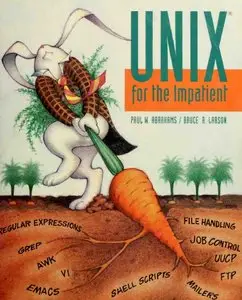Paul W. Abrahams, Bruce R. Larson - Unix for the Impatient
Published: 1992-02 | ISBN: 0201557037 | PDF | 400 pages | 54 MB
"IF YOU ARE THINKING about using UNIX, you must have this book." The popular handbook – now with a hypertext version for the Hyper-Impatient UNIX for the Impatient is is an in-depth, comprehensive guide to UNIX – a handbook you can use both for learning and as a ready reference. Clear, concise, and readable, the book is written for the technically oriented UNIX user who doesn't want to wade through verbose tutorials but isn't already an expert. Its functional organization makes it easy to find the right tool for any task, and an extensive discussion of underlying UNIX concepts, supplemented by a glossary, enables even a UNIX beginner to penetrate the mysteries of UNIX terminology. UNIX for the Hyper-Impatient, on the accompanying CD-ROM, complements the printed book by giving you even more powerful ways to retrieve information quickly. The CD-ROM contains the entire text of the book, together with the DynaText hypertext system for navigating through it. The DynaText software will run on a variety of UNIX systems (with Motif)*, as well as on Microsoft Windows and Macintosh.Valuable features include links for retrieving the syntax and options of any UNIX command as well as its full description; a dynamically expandable table of contents; links for tracing cross-references; search operations over either section headings or the entire text using combinations of terms, phrases, nearby words, or wildcards; facilities for the reader to add personal annotations and hyperlinks; and the ability to save or print excerpts of the book. The CD-ROM also includes the Slackware distribution of Linux, a free but thoroughly professional version of UNIX, and the full set of files for the Emacs editor. This up-to-date and practical work is based on the IEEE POSIX.2 Standard now widely adopted by UNIX vendors and implementors. Important System V, BSD, and GNU variations and enhancements are also presented. Topics include user utilities, shells, the vi editor and other standard editors, the GNU Emacs editor, Internet access tools, the awk language, the X Window System, and system administration from the user's perspective.



